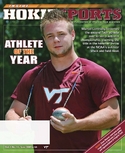In early May, a story broke concerning Tech football players promoting certain events by having their photos appear on fliers, thus creating the potential for NCAA violations. The story created much angst among Hokie Nation, and Tim Parker decided to address the issue in this magazine’s Compliance Corner.
“We all deal with this one,” Parker said. “Every ACC school, every SEC school … we all face this. It’s so easy now to pull photos off the Internet. You just toss it up on the flier. It’s really easy to use anyone else’s image without them knowing about it. It’s actually amazing to me that we don’t have to deal this more, honestly.”
The gist of the story was this: the photos of quarterback Tyrod Taylor and free safety Kam Chancellor appeared on fliers promoting five different events in the Tidewater area last year. Taylor attended three of the events, while Chancellor went to one. Neither knew that their photos had been used on the fliers.
“That’s really the key element,” Parker said. “The names and images were used without their permission. We run into this type of situation a couple times a year, where a promoter will use an athlete’s name or likeness to promote an event. If the event hasn’t occurred, we send out cease-and-desist orders. If the event has already happened, we’ll get in touch with the promoters and make them aware of the NCAA rule so this doesn’t happen again. It’s pretty run-of-the-mill stuff.”
Also, tight end Greg Boone’s photo was used to promote an event, and former Tech players Branden Ore and Purnell Sturdivant saw their photos used as well. None of the players gave their permission for their photos to be used.
According to NCAA Bylaw 12.5.1.1, a student-athlete cannot promote any event unless it’s a non-profit event, and even then, certain criteria must be met. Some of the criteria include:
- • The name or picture of a student-athlete with remaining eligibility may not appear on an institution’s printed promotional item (e.g., poster, calendar) that includes a reproduction of a product with which a commercial entity is associated if the commercial entity’s officially registered regular trademark or logo also appears on the item;
- All moneys derived from the activity or project go directly to the member institution, member conference or the charitable, educational or nonprofit agency;
- The student-athlete’s name, picture or appearance is not used to promote the commercial ventures of any nonprofit agency.
In addition, NCAA bylaw 12.5.2.1 speaks to non-permissible promotions. According to the rule, after one becomes a student-athlete, he or she is not eligible for participation in intercollegiate athletics if: - He or she accepts any remuneration for or permits the use of his or her name or picture to advertise, recommend or promote directly the sale or use of a commercial product or service of any kind; or
- He or she receives remuneration for endorsing a commercial product or service through the individual’s use of such product or service.
Parker met with Taylor, Chancellor and Boone. All three paid their own way to the events and received nothing in the form of compensation. Parker addressed the issue with all three and explained the NCAA’s rationale behind the rules.
The whole issue came to life when Taylor posted photos of one of the events on his Facebook page. One of the fliers served as the profile photo of Taylor’s Facebook page.
“It wasn’t a good decision (to put the fliers up),” Parker said. “But if I’m 20 and I see myself on a poster, I would think, ‘Hey, that’s pretty cool. I’m going to put that on my Facebook.’ I can see why he would do that. Clearly he wasn’t thinking about NCAA rules when he did it.
“But this was a harmless situation and our guys were not involved in the planning or on the front end of this promotion.”




